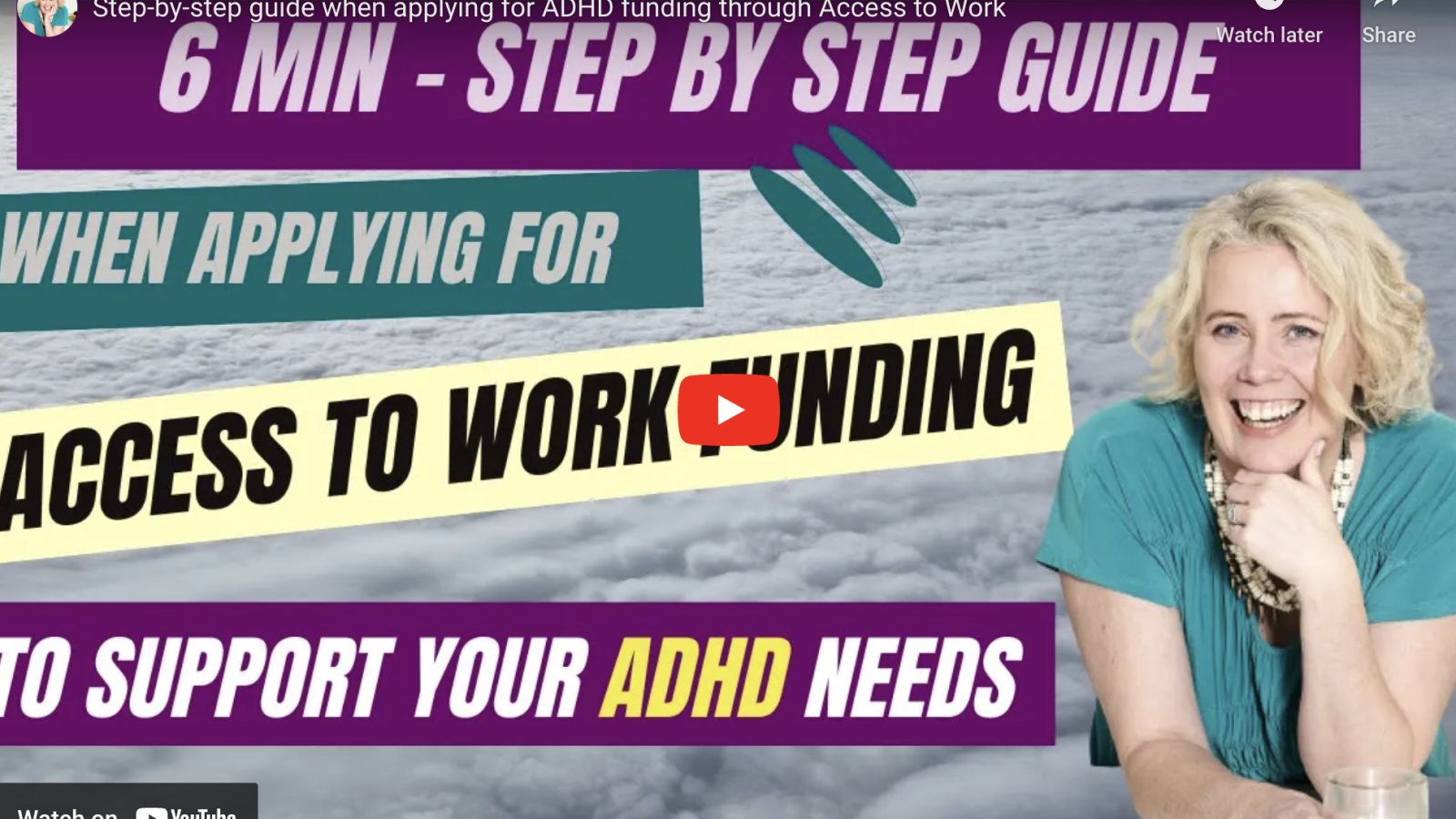Insights

by Tina Squire
•
15 July 2025
It’s probably one of the most common questions I hear, whether it’s from employees trying to figure out what to ask for, or managers nervously Googling how to “do the right thing.” The honest answer? There’s no universal list. No neat handbook that says, “if you have ADHD, you’ll need exactly these things.” Because the truth is, even the most enlightened employers aren’t experts in your brain. If you’ve met a hundred people with ADHD, you’ve met a hundred entirely different brains. However it doesn’t have to be dramatic or expensive. In fact, the best adjustments are often small, human, and tailored to how your brain actually works. That’s why the most important part of this conversation isn’t the list of possible adjustments. It’s understanding what actually works for you. Asking yourself What lights you up at work? When do you feel most settled and focused? What situations leave you scattered, drained, or second-guessing yourself? In my coaching and the resources we’ve created at Adeptina, we always come back to this: adjustments start with self-awareness. Whether it’s noticing you do your best thinking out loud, or that you crumble in noisy spaces, or that written follow-ups keep your working memory from short-circuiting, these are gold dust insights. They’re what allow you to move beyond generic “ADHD tips” and build support that fits you. So if you’re asking, “What are reasonable adjustments for ADHD at work?”, here’s where I’d encourage you to begin: by getting curious about your own patterns, strengths, and needs. Because once you know that, it becomes so much easier to advocate for changes that truly make a difference. How do you figure out what adjustments you actually need? This is often where people get stuck. Even in workplaces that are supportive, many managers will still turn to you and say, “So, what do you need?” It’s a great question, and a hard one. Because if you’ve spent years quietly masking or muddling through, it might not be obvious. So here’s where to start 1. Look for patterns Take a moment to reflect on your typical workday or week. You might ask yourself: What are the moments that consistently trip me up or drain my energy? When do I procrastinate or spin out, even if I care about the work? When have I felt most calm, engaged, or even proud? For example, maybe you notice that long meetings without an agenda make your mind ping off in twenty directions. Or that you always think of your best ideas after you’ve left the meeting room. That’s useful data. It might point to needing agendas in advance, or permission to share follow-up thoughts later. 2. Think about how you process best In our guides, we often encourage people to notice: Are you someone who needs to see it, say it, or move around it? If you’re a visual processor, maybe you need diagrams, mind maps, or a Kanban board to feel organised. If you’re a verbal processor, regular check-ins where you can talk things through might make all the difference. If you thrive on movement, perhaps a walk-and-talk meeting beats a formal sit-down every time. Understanding your brain’s preferred way of taking in and working through information is like unlocking the instruction manual that was missing all along. 3. Dig into what’s helped (or hurt) before Sometimes it’s easier to start by looking backwards. When in the past have you felt most on top of things at work? What was in place then? Was it a clear routine? Was it a manager who sent everything in writing? Was it a role where you could work in intense sprints, then rest? Equally, noticing what hasn’t worked can be just as clarifying. The goal isn’t to pick yourself apart — it’s to gather clues. 4. Keep it practical, not perfect It can be tempting to look for some perfect solution. But most adjustments are simple. They’re tweaks that make it easier to show up as you, not constant workarounds to hide who you are. That might mean: Using noise-cancelling headphones in a busy office Getting project instructions in writing, not just a quick chat Having a short recovery window after intense meetings Or scheduling your most complex work for the time of day when your brain is actually online It sounds simple, but it’s powerful. Because reasonable adjustments aren’t magic. They’re often small, targeted tweaks that make your natural way of working easier. A few examples to get you thinking Sometimes we overcomplicate this. Reasonable adjustments can sound like a formal, intimidating thing. But in reality, they’re often small, thoughtful changes that make your brain’s job easier. Here are a few examples I’ve seen make a genuine difference for people with ADHD at work: Visual project trackers If your brain can’t hold all the moving parts in working memory (honestly, whose can?), having a visual way to see tasks laid out, like a Kanban board, Trello, or even sticky notes on a wall can bring huge relief. It’s about externalising your thoughts so your brain doesn’t have to carry them all at once. Flexible start times Maybe you’re sharper mid-morning, or you crash by 3pm. Being able to start and finish slightly earlier or later can help you match your energy curve, instead of fighting it. Regular “think out loud” sessions If you process ideas by talking them through, it might help to have a standing 15-minute check-in with your manager or a trusted colleague. Just space to verbalise where you’re at can bring clarity and avoid weeks of circling confusion. Written follow-ups If you’re someone who leaves a meeting full of ideas, only to realise later that you can’t remember half of them, ask for a short summary afterwards. Even bullet points can take the pressure off your memory and give you a stable reference point. Permission to step away Open-plan offices can be a sensory gauntlet. Sometimes the adjustment is as simple as having the green light to move to a quieter space or pop on headphones without feeling like you’re being rude. Combining sprints with recovery If you tend to hyperfocus or work in intense bursts, you might also need a conscious buffer afterwards, time to decompress or switch to easier tasks. Building that into your routine can prevent the all-too-common energy hangover. None of these is huge or particularly fancy. But they work because they’re specific to how your brain operates. They take what’s already true about you and make it easier, not harder, to do your job well. A little note on figuring this out I appreciate that spotting these patterns, and making sense of what they mean for you in real life it’s not always something you can do alone. It’s one thing to know you’re tired after certain tasks or that meetings leave your head spinning. But it’s another to really see the thread running through it all. To notice that, oh, this is actually about how you process information, or what energises you, or where your brain’s bandwidth gets eaten up. This is a huge part of what coaching is. There’s a skill (and a kind of deep listening) that we bring. Someone can be telling me a story about a random day at work, or how they handle Monday mornings, or why they hate Slack notifications and under all of that is so much data. About how they think, what their strengths are, where the friction is. It’s often from these ordinary stories that we start to uncover the gold. And that’s what helps turn vague frustrations into actual adjustments you can ask for, that make a difference. So if you’re still wondering “What are reasonable adjustments for ADHD at work?” it really comes down to this: They’re whatever helps you do your best work, with less friction and more ease. They’re whatever bridges the gap between how your brain naturally operates and the demands of your role. And figuring them out, whether that’s on your own, with a trusted friend, or with a coach who knows how to listen between the lines, is one of the most worthwhile things you can do. Whether it’s a small tweak to how meetings run, a bit more visual structure, or simply being able to work when your brain’s switched on, these are all valid. They’re reasonable. And you’re allowed to ask.
by Tina
•
12 August 2024
In response to my post last week about habit trackers and what they are good for, I’ve received a lot of requests for what I would recommend. I am also often asked this by my coaching clients , and essentially it comes down to what you want to track and what your personal requirements and preferences are. Identify Your Goals and Preferences Knowing a bit about your goals and preferences will help you select a habit tracking system that aligns with your objectives. Use this article to consider what you need. The first step to finding the right habit tracker is to understand what you want to accomplish. DO NOT go down that rabbit hole without setting some parameters for what you are looking for, especially if you are neurodivergent. There are many habit tracking service providers, and they are all good at selling the benefits of their product, so the most important thing is to know if you’re interested in the benefits they’re offering. Consider the habits you want to monitor. These might include: Positive habits: Water intake, journal writing, exercise Habits to reduce: Alcohol consumption, excessive screen time Habit tracking can be helpful if, for example, you suffer from time blindness. I am always surprised by how often my head says I haven’t done journaling ‘for ages’ for example and then I check my habit tracker and find out I only wrote something two days ago. Sometimes combating time blindness is about allowing your brain to acknowledge that you do things. Again super important if you are neurodivergent. Other key questions you might want to ask yourself are: Do you want to improve your fitness, enhance your productivity, or manage your time more effectively? Is simplicity more important to you than gamification? Are you a fan of good old fashioned paper and pen or do you have an iPhone or Android that you would like to use? How important is it for your tracker to sync with your laptop or your tablet? Below are some areas to consider when considering your own personal preferences. Some of them may not apply to you, but some might help you figure out what you want from a habit tracker so that you can get one that does the job. In addition to some suggestions, I’ve included some criteria I use myself.

by Tina
•
4 July 2024
For individuals with ADHD, the seemingly simple act of receiving compliments can often feel like navigating a complex emotional maze. The ADHD brain, wired for constant stimulation and self-criticism, tends to dismiss positive feedback, especially regarding tasks or abilities that come naturally. Let’s explore the challenges of accepting compliments for those of us with ADHD and consider what practical strategies there are to overcome these hurdles, ultimately leading to improved self-esteem and social interactions. The ADHD Compliment Conundrum: People with ADHD frequently struggle with low self-esteem and negative self-perception. This can stem from years of struggling with executive function, time management, and societal expectations. As a result, when faced with praise, the ADHD brain may automatically discount or reject the compliment, often before the individual has even fully processed it. Strategies for Success: 1. Embrace Verbal Processing: One effective technique for managing the immediate dismissal of compliments is to verbalise your thoughts. By saying your reactions aloud, you create an opportunity to catch and challenge negative self-talk. This process allows you to consciously examine your thoughts and potentially reframe them in a more positive light. 2. Recognise and Celebrate ADHD Strengths: Many individuals with ADHD possess unique talents and abilities that they may overlook because these skills come easily to them. It’s crucial to understand that what feels “effortless” to you might actually be a special talent. Take time to identify and appreciate your ADHD-related strengths, such as creativity, hyperfocus, or out-of-the-box thinking. 3. Practise Acceptance Through Simple Responses: Even if you don’t fully believe or internalise a compliment, responding with a simple “thank you” can be a powerful first step. This practice acknowledges the other person’s kindness and helps rewire your brain to become more receptive to positive feedback over time. 4. Seek Clarification and Specifics: If a compliment feels vague or difficult to process, it’s perfectly acceptable to ask for more details. Requesting specifics about what the person appreciated can help make the compliment feel more concrete and easier to accept. 5. Reframe Your Perspective on Compliments: Remember that accepting a compliment isn’t solely about you – it’s also about allowing the other person to express their appreciation. By shifting your focus to the giver’s intention, you may find it easier to receive praise graciously. 6. Incorporate Positive Affirmations: Regular use of positive affirmations can help build a more robust and positive self-image. Take time each day to remind yourself of your strengths, accomplishments, and unique qualities. This practice can make it easier to accept external compliments as they align with your internal dialogue. Learning to accept compliments with ADHD is a skill that requires patience and practice. As you implement these strategies, be kind to yourself and acknowledge that change takes time. With consistent effort, you can develop a healthier relationship with praise, leading to improved self-esteem and more positive social interactions. Remember, your ADHD brain may initially resist compliments, but with these tools and techniques, you can learn to embrace and benefit from the positive feedback you receive. Celebrate your progress, no matter how small, and continue to work towards a more confident and self-assured you. You can download our free ebook “Thriving with ADHD at work” and there are also Access To Work resources available .

by Tina
•
3 February 2024
I know I don’t fit the stereotypical image of someone with ADHD. I got good grades in school, and I have a successful career, but I suppose that’s what makes writing this feels important. I got my diagnosis of ADHD, combined type, in Jan 2021. It was a rocky start to the year but overall, it was an overwhelmingly positive experience. Can you imagine what you’d think if an educated professional turned around and told you, “ This is why you are the way you are.” Wouldn’t you be grateful? I was ready to give it a label, and it made me feel more ok about myself and allowed me to lose some of the shame I didn’t even know that I carried around. I felt good about the label as to me, it explained so much. It is as if someone has found the manual that goes with my brain and reading and understanding about my own ADHD has really helped me understand myself better. While I haven’t told many people, I have told a few, and the most common question I get is, “Do you wish you had known sooner?” When I look back all I can see and appreciate is how I navigated my way through school and work, how and why I made certain decisions at times in my life, and I do so without feeling regret or blaming my parents. If anything, it tells me that my abilities are limitless. I also feel positive because, when I look forward, there’s no need to fix anything. I’ll just find what works for me, and that’s ok. As far as my life has gone, I have done well, but I know I have been hard on myself at times, so if anything, this diagnosis has given me permission to be kinder to myself. Here is where having ADHD and getting a diagnosis differs from not knowing that you have it. I’m simply able to allow myself to be …. Happier . I hope that this opens up more conversations about neurodiversity. I’m certainly open to questions and discussions. What are your thoughts?

by Tina
•
2 February 2024
Access To Work updated their online application in October 2023. This video pertains to the application process before this change. In this video, I created a step-by-step tutorial guide to help people with ADHD easily apply to the Access to Work grant scheme. This scheme allows individuals to access funding for things like ADHD coaching, assistive technology, and support workers. Applying for this grant can be a daunting process, especially for those with ADHD. However, my tutorial simplifies the process and breaks it down into easy-to-follow steps. By the end of the video, viewers will have a clear understanding of how to apply for the grant and will be one step closer to accessing the support they need to thrive in the workplace.

by Tina
•
20 January 2024
The Link, Impact of Dopamine, and 4 Pillars for Recovery Looking to understand addiction and ADHD? This video will explore the connection between ADHD and addiction, including how the symptoms of ADHD make individuals more susceptible to addictive behaviours. You’ll learn about the impact of dopamine on addiction and how medication can be used to help reduce the risk of addiction. We’ll also provide you with four pillars to help protect yourself from addiction, including education, prevention, awareness, and self-care. If you or a loved one is struggling with addiction, this video will provide valuable insights to help guide you on your journey towards recovery.

by Tina
•
14 November 2023
In today’s fast-paced and demanding professional landscape, individuals with ADHD often face unique challenges. The workplace can be a battleground of distractions, deadlines, and constant pressure, making it difficult for those with ADHD to navigate and excel. As a certified ADHD and life coach, I understand that thriving in such an environment requires not only self-awareness and resilience but also effective advocacy for your unique needs. In this blog, we’ll explore strategies to help professionals with ADHD not only survive but thrive in their careers while confidently advocating for themselves. 1. Embrace Your Strengths While ADHD can present challenges, it also brings a unique set of strengths. Individuals with ADHD often possess creativity, hyperfocus, and out-of-the-box thinking. However, it is important for your place of work to recognise that you are just that, an individual. Each person with ADHD is uniquely wired and with that, bring their own skill set. You need to embrace your unique set of skills and leverage them to your advantage in the workplace. Identify tasks that align with your strengths, allowing you to shine and make a meaningful impact. 2. Develop Self-Awareness Understanding how ADHD manifests in your daily work life is crucial for success. Take the time to identify your triggers, distractions, and optimal working conditions. Are you more productive during specific times of the day? Do certain environments enhance your focus? Knowing what makes you happy alongside your strengths and challenges will empower you to create a work routine that maximises your productivity and minimises stress. 3. Implement Time Management Techniques Time management is a common struggle for individuals with ADHD, but it can be conquered with the right strategies. Break down tasks into smaller, more manageable steps, and use tools such as calendars, planners, or task management apps to stay organised. Set realistic deadlines and prioritise tasks to avoid feeling overwhelmed. Regularly reviewing and adjusting your schedule can help you stay on track. 4. Create a Supportive Workspace Designing a workspace that minimises distractions and maximises focus is essential. Consider factors such as lighting, noise levels, and organisation. Noise-cancelling headphones, task lighting, and decluttering your workspace can create a more conducive environment for concentration. Communicate with your colleagues about your needs and work together to create a supportive office culture. 5. Advocate for Accommodations You may feel uncomfortable telling your employer about your ADHD but don’t hesitate to communicate your needs to your employer if they need to make accommodations for you so that you thrive in your workplace, enhancing performance. Whether it’s flexible work hours, remote work options, or specific tools and technologies, advocating for reasonable accommodations is a key aspect of self-advocacy.You might find that your company suggests working in a calmer, quiet environment, yet you struggle with the silence. Maybe you work better in groups where there is background noise. Make sure your employer knows what you need and how they can help you achieve that. Clearly articulate how these accommodations will benefit both you and the organisation. 6. Build Strong Relationships Cultivating positive relationships with colleagues and supervisors is crucial for professional success. Communicate openly about your strengths and challenges, fostering an environment of understanding and support. Educate your team about ADHD, dispelling myths and promoting a culture of inclusivity. Strong relationships can lead to increased collaboration and a more harmonious work environment. The real job satisfaction comes from a feeling of being trusted at work. Your employer should recognise that you can achieve the business goals set, even if it means achieving them in a different way to other employees. The end result is exactly the same. 7. Leverage Technology Take advantage of technology to streamline your work processes. Task management apps, reminders, and productivity tools can be invaluable for staying organised and on track. Set up alerts for deadlines, meetings, and important tasks to help you manage your time effectively. Experiment with different apps to find the ones that align with your preferred working style. 8. Invest in Professional Development Continuous learning and skill development are essential for career growth. Identify areas where you can enhance your skills and knowledge, and pursue professional development opportunities. This proactive approach not only demonstrates your commitment to personal growth but also positions you as a valuable asset to your organisation. 9. Practice Mindfulness and Stress Management The demands of the workplace can be stressful, especially for individuals with ADHD. Incorporate mindfulness and stress management techniques into your daily routine. Whether it’s meditation, deep breathing exercises, or regular breaks to clear your mind, these practices can help you maintain focus and resilience in the face of challenges. 10. Seek Mentorship Connect with an ADHD coach like myself who understands the nuances of navigating the professional world with ADHD. Seek guidance from individuals who have successfully overcome similar challenges. Their insights and advice can be invaluable as you navigate your career path. Additionally, consider joining support groups or online communities where you can share experiences and learn from others with ADHD. In conclusion, thriving in the workplace with ADHD is not only possible but can lead to remarkable success. By embracing your strengths, developing self-awareness, advocating for accommodations, and fostering positive relationships, you can create a work environment that supports your unique needs. Remember, you are not alone in this journey, and by advocating for yourself, you contribute to a workplace culture that values diversity and inclusivity. With the right strategies and mindset, you can not only overcome the challenges associated with ADHD but also excel in your professional endeavours. Maybe you’ve just been diagnosed and are struggling to decipher all the information about ADHD, how it pertains to you and how you can confidently but also authentically build the work environment that is conducive for you. Book a call with me and we can chat through how you can embrace your neurodiversity and allow yourself to thrive.
